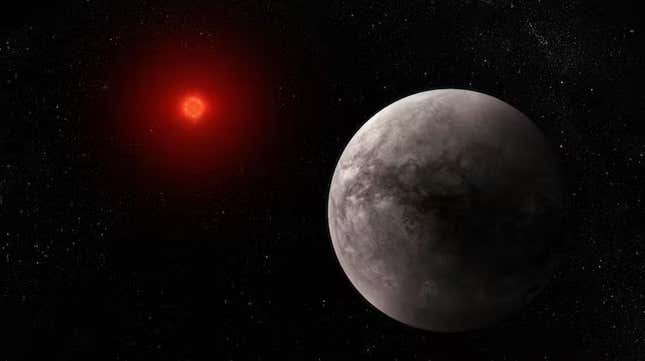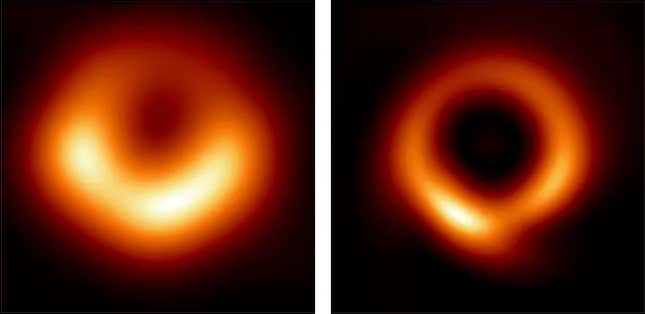
The well-known first picture of a black gap just got two times sharper. A analysis group used synthetic intelligence to dramatically enhance upon its first image from 2019, which now reveals the black gap on the heart of the M87 galaxy as darker and greater than the primary picture depicted.
I’m an astronomer who research and has written about cosmology, black holes and exoplanets. Astronomers have been utilizing AI for many years. In truth, in 1990, astronomers from the College of Arizona, the place I’m a professor, have been among the many first to use a type of AI called a neural network to check the shapes of galaxies.
Since then, AI has unfold into each discipline of astronomy. Because the expertise has grow to be extra highly effective, AI algorithms have begun serving to astronomers tame huge information units and uncover new information concerning the universe.
Higher telescopes, extra information
So long as astronomy has been a science, it has concerned making an attempt to make sense of the multitude of objects within the evening sky. That was comparatively easy when the one instruments have been the bare eye or a easy telescope, and all that might be seen have been a couple of thousand stars and a handful of planets.
100 years in the past, Edwin Hubble used newly constructed telescopes to indicate that the universe is full of not simply stars and clouds of fuel, but countless galaxies. As telescopes have continued to enhance, the sheer variety of celestial objects people can see and the amount of data astronomers must kind by have each grown exponentially, too.
For instance, the soon-to-be-completed Vera Rubin Observatory in Chile will make photographs so massive that it will take 1,500 high-definition TV screens to view every one in its entirety. Over 10 years it’s anticipated to generate 0.5 exabytes of knowledge – about 50,000 occasions the quantity of data held in all the books contained inside the Library of Congress.
There are 20 telescopes with mirrors bigger than 20 toes (6 meters) in diameter. AI algorithms are the one means astronomers might ever hope to work by all the information obtainable to them as we speak. There are a selection of the way AI is proving helpful in processing this information.

One of many earliest makes use of of AI in astronomy was to pick the multitude of faint galaxies hidden within the background of photographs.
ESA/Webb, NASA & CSA, J. Rigby, CC BY
Choosing out patterns
Astronomy typically entails searching for needles in a haystack. About 99% of the pixels in an astronomical picture include background radiation, gentle from different sources or the blackness of area – only one% have the delicate shapes of faint galaxies.
AI algorithms – specifically, neural networks that use many interconnected nodes and are in a position to be taught to acknowledge patterns – are completely suited to choosing out the patterns of galaxies. Astronomers started using neural networks to classify galaxies within the early 2010s. Now the algorithms are so effective that they’ll classify galaxies with an accuracy of 98%.
This story has been repeated in different areas of astronomy. Astronomers engaged on SETI, the Seek for Extraterrestrial Intelligence, use radio telescopes to search for indicators from distant civilizations. Early on, radio astronomers scanned charts by eye to look for anomalies that couldn’t be defined. Extra not too long ago, researchers harnessed 150,000 private computer systems and 1.8 million citizen scientists to search for synthetic radio signals. Now, researchers are utilizing AI to sift by reams of knowledge way more shortly and completely than individuals can. This has allowed SETI efforts to cowl extra floor whereas additionally drastically lowering the number of false positive signals.
One other instance is the seek for exoplanets. Astronomers found a lot of the 5,300 known exoplanets by measuring a dip within the quantity of sunshine coming from a star when a planet passes in front of it. AI instruments can now select the indicators of an exoplanet with 96% accuracy.

AI instruments will help astronomers uncover new exoplanets like TRAPPIST-1 b.
NASA, ESA, CSA, Joseph Olmsted (STScI), CC BY
Making new discoveries
AI has proved itself to be glorious at figuring out recognized objects – like galaxies or exoplanets – that astronomers inform it to search for. However it’s also fairly highly effective at discovering objects or phenomena which are theorized however haven’t but been found in the actual world.
Groups have used this strategy to detect new exoplanets, be taught concerning the ancestral stars that led to the formation and progress of the Milky Method, and predict the signatures of latest kinds of gravitational waves.
To do that, astronomers first use AI to transform theoretical fashions into observational signatures – together with lifelike ranges of noise. They then use machine studying to sharpen the power of AI to detect the expected phenomena.
Lastly, radio astronomers have additionally been utilizing AI algorithms to sift by indicators that don’t correspond to recognized phenomena. Just lately a group from South Africa discovered a unique object that could be a remnant of the explosive merging of two supermassive black holes. If this proves to be true, the information will permit a brand new take a look at of common relativity – Albert Einstein’s description of space-time.

The group that first imaged a black gap, at left, used AI to generate a sharper model of the picture, at proper, exhibiting the black gap to be bigger than initially thought.
Making predictions and plugging holes
As in lots of areas of life not too long ago, generative AI and huge language fashions like ChatGPT are additionally making waves within the astronomy world.
The group that created the primary picture of a black gap in 2019 used a generative AI to produce its new image. To take action, it first taught an AI find out how to acknowledge black holes by feeding it simulations of many sorts of black holes. Then, the group used the AI mannequin it had constructed to fill in gaps within the huge quantity of knowledge collected by the radio telescopes on the black gap M87.
Utilizing this simulated information, the group was in a position to create a brand new picture that’s two occasions sharper than the unique and is absolutely per the predictions of common relativity.
Astronomers are additionally turning to AI to assist tame the complexity of recent analysis. A group from the Harvard-Smithsonian Heart for Astrophysics created a language model called astroBERT to learn and arrange 15 million scientific papers on astronomy. One other group, based mostly at NASA, has even proposed utilizing AI to prioritize astronomy projects, a course of that astronomers have interaction in each 10 years.
As AI has progressed, it has grow to be a necessary device for astronomers. As telescopes get higher, as information units get bigger and as AIs proceed to enhance, it’s seemingly that this expertise will play a central function in future discoveries concerning the universe.
Wish to know extra about AI, chatbots, and the way forward for machine studying? Take a look at our full protection of artificial intelligence, or browse our guides to The Best Free AI Art Generators and Everything We Know About OpenAI’s ChatGPT.
Chris Impey, College Distinguished Professor of Astronomy, University of Arizona
This text is republished from The Conversation below a Artistic Commons license. Learn the original article.
Trending Merchandise

Cooler Master MasterBox Q300L Micro-ATX Tower with Magnetic Design Dust Filter, Transparent Acrylic Side Panel…

ASUS TUF Gaming GT301 ZAKU II Edition ATX mid-Tower Compact case with Tempered Glass Side Panel, Honeycomb Front Panel…

ASUS TUF Gaming GT501 Mid-Tower Computer Case for up to EATX Motherboards with USB 3.0 Front Panel Cases GT501/GRY/WITH…

be quiet! Pure Base 500DX Black, Mid Tower ATX case, ARGB, 3 pre-installed Pure Wings 2, BGW37, tempered glass window

ASUS ROG Strix Helios GX601 White Edition RGB Mid-Tower Computer Case for ATX/EATX Motherboards with tempered glass…










